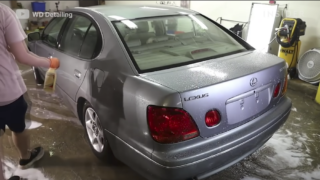Lexus Teammate the Only ADAS System to Earn ‘Acceptable’ Rating From IIHS
The new IIHS partial driving automation test is aimed at improving existing systems, but Lexus Teammate is already ahead of the curve.
In recent years, the Insurance Institute of Highway Safety (IIHS) has been busy updating its many testing standards as automobiles continue to evolve. The bulk of these changes pertain to the rise of advanced driver assistance systems (ADAS), which involves things like automatic emergency braking, automatic cruise control, and partially-autonomous features, to boot. As one might imagine, these more stringent standards have resulted in mostly failures on the behalf of those systems, but that wasn’t the case with the Lexus Teammate feature, it seems.
Rather, the IIHS recently rolled out its brand new ratings program for these partial driving automation systems, which is designed to evaluate them and also encourage automakers to make improvements. Ultimately, IIHS tested 14 different systems, and the results were quite alarming – out of that 14, 11 were rated poorly, two received a marginal score, and just one – Lexus Teammate – earned an acceptable rating.
IIHS looked at the Lexus Teammate system in the LS sedan, specifically, putting it and the other 13 similar features to a variety of tests in multiple categories:
- Driver monitoring – a system’s ability to detect if the driver’s head or eyes are not directed at the road and whether the their hands are on the steering wheel or ready to grab it if necessary.
- Attention reminders – when a partial automation system detects that the driver’s eyes aren’t focused on the road or their hands aren’t ready to take over the steering, it should begin a dual-mode alert, such as an audible and visual warning, within 10 seconds. Before the 20-second mark, it should add a third mode of alert or begin an emergency procedure to slow the vehicle.
- Emergency procedures – appropriate emergency escalation procedures should be provided, and if the driver does not respond, systems should begin a slowdown procedure within 35 seconds of driver disengagement. If the driver ignores these warnings, the system should send an SOS message to emergency responders or a 24-hour help center, and the driver should be prevented from restarting the automation for the remainder of the drive.
- Driver involvement – lane changes should be initiated or confirmed by the driver. When traffic causes the ACC to bring the vehicle to a complete stop, it should not automatically resume unless the system can confirm the driver is looking at the road and no more than two minutes have passed. The lane-centering feature should not switch off automatically when the driver makes manual steering adjustments within the lane, as that can discourage drivers from being physically involved in the driving, and physical involvement can help prevent mental disengagement.
- Safety features – these systems can only be used when proven safety features are engaged, including seat belts, AEB, and lane departure prevention. For a good rating in this category, a partial automation system should not switch on if the driver is unbelted or AEB or lane departure prevention is not active. If already in operation and the driver unfastens their seat belt, the system should immediately begin its multi-mode, driver-disengagement attention reminders. Finally, it must be impossible to switch off AEB or lane departure prevention if the automation is engaged.
After being subjected to these standards, the Lexus Teammate system earned its acceptable overall rating thanks to scores of marginal in driver monitoring, acceptable in emergency procedures and ACC resume, and good ratings in attention reminders, lane change, cooperative steering, and safety features. Regardless, the results of the test, overall, signal that improvement is needed across the board – though that shouldn’t be too difficult to accomplish.
“These results are worrying, considering how quickly vehicles with these partial automation systems are hitting our roadways,” said IIHS President David Harkey. “But there’s a silver lining if you look at the performance of the group as a whole. No single system did well across the board, but in each category at least one system performed well. That means the fixes are readily available and, in some cases, may be accomplished with nothing more than a simple software update.”






